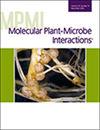求助PDF
{"title":"三重威胁:全球真菌水稻和小麦病原体如何利用可比的致病性机制来驱动寄主定植。","authors":"Rachel E Kalicharan, Jessie Fernandez","doi":"10.1094/MPMI-09-24-0106-FI","DOIUrl":null,"url":null,"abstract":"<p><p>Plant pathogens pose significant threats to global cereal crop production, particularly for essential crops such as rice and wheat, which are fundamental to global food security and provide nearly 40% of the global caloric intake. As the global population continues to rise, increasing agricultural production to meet food demands becomes even more critical. However, the production of these vital crops is constantly threatened by phytopathological diseases, especially those caused by fungal pathogens such as <i>Magnaporthe oryzae</i>, the causative agent of rice blast disease; <i>Fusarium graminearum</i>, responsible for <i>Fusarium</i> head blight in wheat; and <i>Zymoseptoria tritici</i>, the source of Septoria tritici blotch. All three pathogens are hemibiotrophic, initially colonizing the host through a biotrophic, symptomless lifestyle, followed by causing cell death through the necrotrophic phase. Additionally, they deploy a diverse range of effectors, including proteinaceous and non-proteinaceous molecules, to manipulate fundamental host cellular processes, evade immune responses, and promote disease progression. This review discusses recent advances in understanding the effector biology of these three pathogens, highlighting both the shared functionalities and unique molecular mechanisms they employ to regulate conserved elements of host pathways, such as directly manipulating gene transcription in host nuclei, disrupting reactive oxygen species signaling, interfering with protein stability, and undermining host structural integrity. By detailing these complex interactions, the review explores potential targets for innovative control measures and emphasizes the need for further research to develop effective strategies against these destructive pathogens in the face of evolving environmental and agricultural challenges. [Formula: see text] Copyright © 2025 The Author(s). This is an open access article distributed under the CC BY-NC-ND 4.0 International license.</p>","PeriodicalId":19009,"journal":{"name":"Molecular Plant-microbe Interactions","volume":" ","pages":"173-186"},"PeriodicalIF":3.4000,"publicationDate":"2025-03-01","publicationTypes":"Journal Article","fieldsOfStudy":null,"isOpenAccess":false,"openAccessPdf":"","citationCount":"0","resultStr":"{\"title\":\"Triple Threat: How Global Fungal Rice and Wheat Pathogens Utilize Comparable Pathogenicity Mechanisms to Drive Host Colonization.\",\"authors\":\"Rachel E Kalicharan, Jessie Fernandez\",\"doi\":\"10.1094/MPMI-09-24-0106-FI\",\"DOIUrl\":null,\"url\":null,\"abstract\":\"<p><p>Plant pathogens pose significant threats to global cereal crop production, particularly for essential crops such as rice and wheat, which are fundamental to global food security and provide nearly 40% of the global caloric intake. As the global population continues to rise, increasing agricultural production to meet food demands becomes even more critical. However, the production of these vital crops is constantly threatened by phytopathological diseases, especially those caused by fungal pathogens such as <i>Magnaporthe oryzae</i>, the causative agent of rice blast disease; <i>Fusarium graminearum</i>, responsible for <i>Fusarium</i> head blight in wheat; and <i>Zymoseptoria tritici</i>, the source of Septoria tritici blotch. All three pathogens are hemibiotrophic, initially colonizing the host through a biotrophic, symptomless lifestyle, followed by causing cell death through the necrotrophic phase. Additionally, they deploy a diverse range of effectors, including proteinaceous and non-proteinaceous molecules, to manipulate fundamental host cellular processes, evade immune responses, and promote disease progression. This review discusses recent advances in understanding the effector biology of these three pathogens, highlighting both the shared functionalities and unique molecular mechanisms they employ to regulate conserved elements of host pathways, such as directly manipulating gene transcription in host nuclei, disrupting reactive oxygen species signaling, interfering with protein stability, and undermining host structural integrity. By detailing these complex interactions, the review explores potential targets for innovative control measures and emphasizes the need for further research to develop effective strategies against these destructive pathogens in the face of evolving environmental and agricultural challenges. [Formula: see text] Copyright © 2025 The Author(s). This is an open access article distributed under the CC BY-NC-ND 4.0 International license.</p>\",\"PeriodicalId\":19009,\"journal\":{\"name\":\"Molecular Plant-microbe Interactions\",\"volume\":\" \",\"pages\":\"173-186\"},\"PeriodicalIF\":3.4000,\"publicationDate\":\"2025-03-01\",\"publicationTypes\":\"Journal Article\",\"fieldsOfStudy\":null,\"isOpenAccess\":false,\"openAccessPdf\":\"\",\"citationCount\":\"0\",\"resultStr\":null,\"platform\":\"Semanticscholar\",\"paperid\":null,\"PeriodicalName\":\"Molecular Plant-microbe Interactions\",\"FirstCategoryId\":\"99\",\"ListUrlMain\":\"https://doi.org/10.1094/MPMI-09-24-0106-FI\",\"RegionNum\":3,\"RegionCategory\":\"生物学\",\"ArticlePicture\":[],\"TitleCN\":null,\"AbstractTextCN\":null,\"PMCID\":null,\"EPubDate\":\"2025/4/17 0:00:00\",\"PubModel\":\"Epub\",\"JCR\":\"Q2\",\"JCRName\":\"BIOCHEMISTRY & MOLECULAR BIOLOGY\",\"Score\":null,\"Total\":0}","platform":"Semanticscholar","paperid":null,"PeriodicalName":"Molecular Plant-microbe Interactions","FirstCategoryId":"99","ListUrlMain":"https://doi.org/10.1094/MPMI-09-24-0106-FI","RegionNum":3,"RegionCategory":"生物学","ArticlePicture":[],"TitleCN":null,"AbstractTextCN":null,"PMCID":null,"EPubDate":"2025/4/17 0:00:00","PubModel":"Epub","JCR":"Q2","JCRName":"BIOCHEMISTRY & MOLECULAR BIOLOGY","Score":null,"Total":0}
引用次数: 0
引用
批量引用

 求助内容:
求助内容: 应助结果提醒方式:
应助结果提醒方式:


